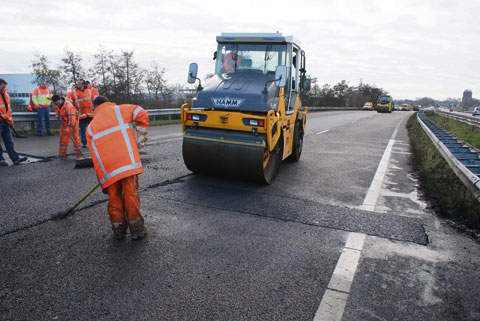By heating up asphalt with an induction cooker, Delft researchers aim to keep the Netherlands’ highways in perfect shape.
Travellers on the A58 from Vlissingen to Bergen op Zoom please slow down. The right lane is closed this week to allow asphalt researcher, Dr Erik Schlangen, and his postdoc researcher, Alvaro Garcia (both of the faculty of Civil Engineering and Geoscience), to drill dozens of holes in a 400-meter long stretch of the road and take samples for subsequent experimentation.
Last December road workers resurfaced this section of the highway using a special type of asphalt developed by the Delft researchers: the blacktop contains 1-centimetre long steel fibres, an additive that is meant to make the asphalt self-healing.
“Due to the fibres, the asphalt is conductive and can thus be heated by holding a coil above it, which generates an alternating magnetic field,” Garcia explains. When the bitumen in the asphalt heats up to about 60 or 70°C, it softens and the tiny cracks in the asphalt close.
Dr Schlangen believes the life-spans of many blacktop surfaces can be doubled to about 12 years if steel fibres are added during the fabrication process and if the asphalt is subsequently heated approximately once per year, using a specially equipped vehicle that passes a large heated coil over the road surface.
The type of material Dr Schlangen is studying is called Zoab, a highly porous asphalt concrete that is much-used in the Netherlands because of its excellent water-draining properties: water seeps through the openings in the asphalt.
The main problem with this asphalt however is that, owing due to temperature cycles, wetting and drying cycles, UV lighting and traffic loads, the bitumen becomes brittle and cracks after just a couple years of use. Ravelling – the process by which the surface layer’s small stones are dislodged – then occurs. But by occasionally heating the asphalt, the micro cracks close again and the aging process slows down.
“In Spain, we don’t have to heat the asphalt with these kind of tricks,” says Garcia, a Spaniard, laughing. “During hot summers the sun heats it to 60 or 70°C.” He adds however that under such conditions heating is in fact not a good thing: “If the asphalt is heated for too long, this also damages the road. You only want to heat the asphalt for a very short time.”
The 120 drill cores taken from the A58 will be exposed to varying climate regimes. “We want to speed up the asphalt’s aging process,” Schlangen explains. “Subsequently, we want to discover how often the material must be heated to extend its lifetime, and how this depends on climatic situations.”
”Via Hyves werd ik een paar jaar geleden benaderd. Puur als hobby doe ik af en toe modellenwerk en daarbij houd ik van auto’s, vooral van Austin Martins. Ik denk dat ze daarom bij mij uitkwamen. In eerste instantie nam ik het niet serieus, maar als snel bleek dat degene die mij benaderde ook écht dames zocht. Hij was net ervoor begonnen iets op te zetten. Op Hyves las ik leuke verhalen van andere grid girls en toen besloot ik om het te doen.
Er gaat geen cursus aan vooraf. Je gaat er gewoon heen en krijgt, naast een shirt en petje, een briefing hoe je moet lopen en staan. Vóórdat de auto’s het circuit opkomen, lopen we met zijn allen vanaf de startlijn tegen de rijrichting in. Om de beurt haakt iemand uit de rij af, om bij een startpositie te gaan staan. Tegelijk houdt diegene een bord omhoog met de naam van de coureur erop. Dat is voor het publiek, een showelement dus. Als de auto’s er staan, zit het werk erop. Een paar van ons zijn er nog nodig bij de prijsuitreiking.”
Tussen de races door lopen we door de Paddock, het gebied waar de teams zich ophouden. Het publiek kan hiervoor speciale kaarten kopen, dus moeten we vriendelijk lachen, met mensen op de foto en doen alsof we het heel erg fantastisch vinden. Met de andere meiden is het best gezellig. Alleen de meesten zijn nogal van die tuthola’s. Ze vinden zichzelf geweldig en zitten de hele dag in de kleedkamer hun neus te poederen, hilarisch als je die verhalen soms hoort. Ik neem het gelukkig niet te serieus.
Het grappige is dat je voor dit werk echt geen model hoeft te zijn. Een leuke uitstraling is al voldoende. Zelfs in België op het Formule 1-circuit gaat het er niet heel officieel aan toe. Eigenlijk zijn het gewoon hobbyisten. Het is best mogelijk om daar een keer te werken, maar dan zou ik wel eerst een netwerkje moeten aanboren, ja.”
Bijbaan: Grid girl
Verdiensten: €12 per uur
Opvallend:Is in tegenstelling tot veel collega’s wél autoliefhebber



Comments are closed.